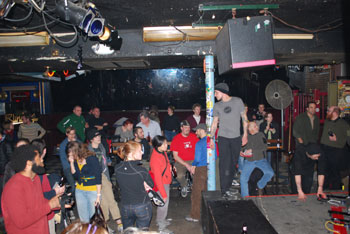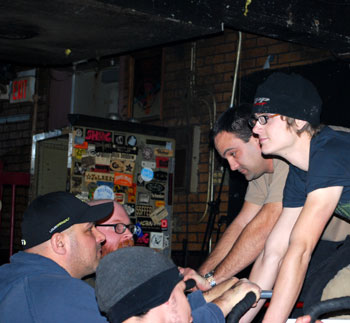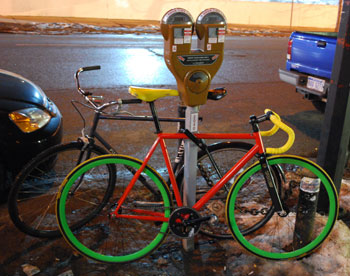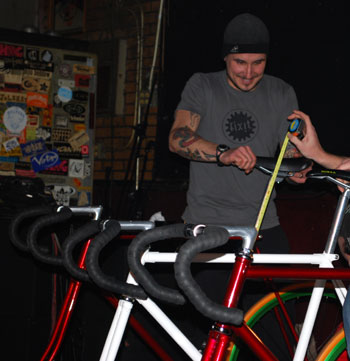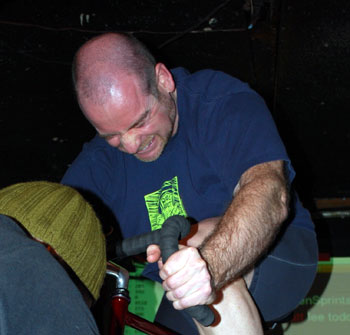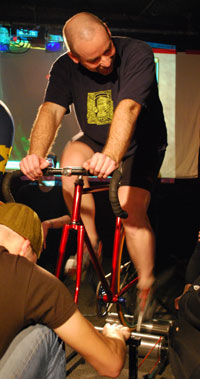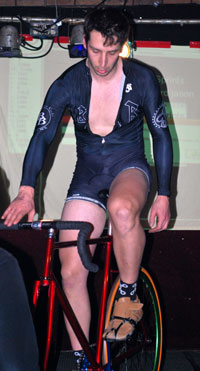Pedaling at The Pig!

Cory Dubrish, who rides for the University of Michigan cycling team, taps out a terrific rhythm on the pedals at the roller races at the Blind Pig on Monday night. He had the pedals ticking over at better than 200 rpm for a second-place finish overall.
Do you like your bicycling excitement measured out in 20-second doses? On Monday night, The Blind Pig on First Street played host to 500-meter bicycle races – sprinted out on stationary rollers lined up across the stage. Winners of the two divisions (men’s and women’s) took home $50 gift certificates from Ann Arbor Cyclery.
The event attracted around 50 participants, among them Jon Royal, who pedaled to The Pig from South Lyon just to take part. As a trailing spouse, he moved there recently from Milwaukee, where he was a bicycle messenger.
On Monday, Royal was looking forward to paying the entry fee of $1 for folks in his line of work – which was a discount from the $5 charged to non-messengers. He was prepared to show race organizers his tag book (the notebook where he kept a record of his calls for pickups and deliveries) in the event there was any question.
The roller races were organized and staged by Dennis Bean-Larson of Fixed Gear Gallery, an internet nexus for all things related to fixed gear bikes (no coaster brake or freewheeling on these bicycles, which are favored by many bicycle messengers). Bean-Larson drove the competition bicycles, rollers, and computer gear down to Ann Arbor from Traverse City, where the FGG enterprise is based, along with its affiliated cycling apparel company, Hell Yes Clothing. Bean-Larson described the gallery and the clothing line as a family business and that was in evidence Monday, as Bean-Larson was assisted throughout the evening by his son, Carl, who also competed in the contest.
Roller Racing Gear
How exactly do bicycle roller races work Fixed-Gear-Gallery style?

The men's final was contested by (left to right) Christopher Ridgard (17.909), Cory Dubrish (17.404), Todd Hayes (16.556). Stabilizing the bikes (left to right) were Thomas Kula, Matt Churches, and Brian Jankowski.
First off, it’s important to understand where bicycle rollers fit in the range of various indoor trainers for cycling. They’re used in conjunction with a bicycle, as opposed to a Spinning® machine, which is a single unit for indoor training only. They’re also different from indoor trainers that clamp the rear tire against a single roller that is attached to some kind of unit using wind, magnets, or internal fluid to create resistance. What makes rollers different is that the rear tire rests on two rollers, each a couple of feet wide, with nothing but the force of gravity and the cyclist’s minor balance corrections to keep the rear wheel vertical and spinning somewhere along the width of the rollers.
The front tire, too, rests on a roller, which is connected to the closer rear roller by a pulley, so the rotation of the front roller matches the rear roller, and cyclists get a training experience that has a “road feel,” because they have to maintain proper balance to stay upright, and they have only the width of the rollers as a margin of error. It’s not a trivial accomplishment for a recreational cyclist to stay upright riding on rollers.
This is the sort of set-up that Spencer Olinek rides at home in his room. Olinek competed Monday night and demonstrated that he’s not a mere recreational cyclist by posting one of the faster qualifying times.
Given the violent efforts associated with sprinting for around 20 seconds to cover a virtual distance of 500 meters, how smart is it to conduct the competition on regular rollers? Not very. That’s why race organizers use a fork-mount stabilizer accessory, which replaces the front wheel with a stand with two widely-spaced feet.

Dennis Bean-Larson of Fixed Gear Gallery came down from Traverse City with his son, Carl, and Erin Chamberlain, to stage the roller races. They're repeating the races at The Blind Pig on Feb. 23.
On top of that, each of the three bicycle-plus-roller configurations need someone hanging off the front handlebars to lend the whole configuration some additional stability. That’s what all the people in the photos are doing, who to the uninitiated might look like they’re praying to their personal cycling god.
The competition thus runs by heats of three cyclists at a time. It’s measured and managed through computer software. Magnets attached to the front roller count revolutions, and that information is relayed to a laptop computer running a software package called OpenSprints, which was created for the Linux opertating system. In real time, OpenSprints translates revolutions into distance and plots the distance that each cyclist has covered as a bar that lengthens until it hits the 500-meter mark.
It’s thus possible to tell as the sprint unfolds, based on bar length, who’s winning. As an added convenience, it makes it possible to let a cyclist know when they’ve finished their 500 meters, so that they can suspend their efforts.
The Competition: Heats and More Heats
Wasting energy by pedaling past 500 meters is not a good strategy in a heat-based competition where cyclists must perform multiple times. Cyclists first competed in a qualifying heat which was the basis of their sorting into the groupings for the subsequent elimination heats. So everyone who participated rode at least twice. Each ride lasted around 20 seconds.

Christina Jovanovic cranked her way to a second place finish in the women's division. Keeping the front assembly steady was Andy Hromadka.
Bean-Larsen announced the record time from a recent Traverse City competition as 17.804 seconds, which amounted to 207 rpms or 63.88 mph, he said. No one at The Blind Pig approached that time until Todd Hayes was able to put a roller hardware issue from an early heat behind him and take a second off the Traverse City time. Hayes would later lower the time to 16.547 in the semi-final heat, and went on to win the finals as well.
The win came with some minor controversy concerning Hayes’ Speedplay® pedals, which organizers allowed him to use, when he explained that he had problems with his knees that would be exacerbated by strapping in with the toe-clips and straps. (Speedplay® markets their pedals and shoes as allowing more freedom of movement than conventional pedal systems.) Other participants who brought their own pedal and shoe combinations weren’t accommodated. If there was a price that Hayes paid for using the pedals, then it was in the merciless teasing meted out by Bean-Larson over the PA for “probably having a sponsorship contract with Speedplay®.”
Hayes was at The Pig supporting the ride of his ex, Laura Johnson, who won the women’s division.
More Spectating Opportunities for Bicycle Roller Racing
The vast majority of Blind Pig patrons on Monday were there to compete in the races. And some of those few folks who seemed like they were there just to spectate wound up taking a turn on the rollers. The Chronicle speculates that Laura (not Laura Johnson) and Jess, who were committed to solidarity in cosmetics (sorry, we don’t have complete details), might have fit that category when they competed in a one-off heat for a Hell Yes T-shirt.
Even though Bean-Larson figured he would be losing money on the trip down to Ann Arbor from Traverse City, once the cost of the rented van was factored in, they’ll be doing it again in two weeks on Feb. 23 at the same venue. That will make for another long night for the Bean-Larsons. According to the Hell Yes Sprints blog, they didn’t make it back home to Traverse City until 6:30 a.m. Tuesday morning.

Laura Johnson, winner of the women's division, cranks away as her ex-Todd (not her current Todd) keeps the bars steady.
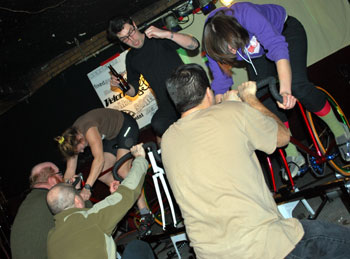
The women's final was contested by Laura Johnson and Christina Jovanovic. Erin Chamberlain (center) was serving as a placeholder so the racing software would analyze the two-person heat correctly. Stabilizing the bikes were Thomas Kula, Todd Hayes, and Andy Hromadka.

Sam Tai demonstrated that the event was not necessarily a monument to health and fitness – but rather to fun. He won this heat.
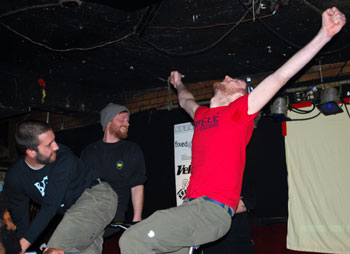
Can you say celebrate? Adam Say executes a victory salute, but the heat had been aborted due to a technical glitch.





